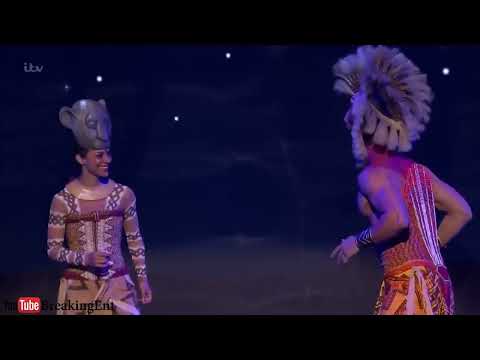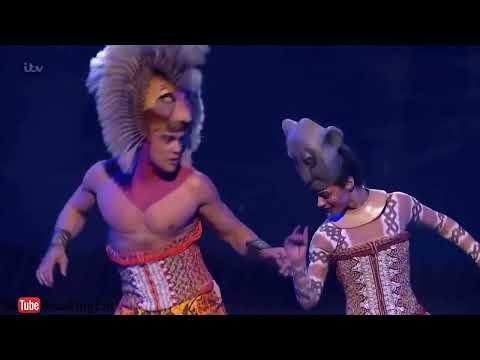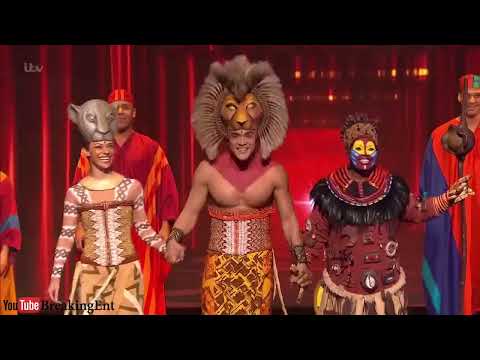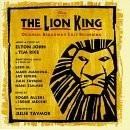Can You Feel the Love Tonight? Lyrics
Can You Feel the Love Tonight?
TIMON:I can see what's happening
PUMBAA:
What?
TIMON:
And they don't have a clue
PUMBAA:
Who?
TIMON:
They'll fall in love
And here's the bottom line
Our trio's down to two
PUMBAA:
Oh
TIMON:
The sweet caress of twilight
There's magic everywhere
And with all this romantic atmosphere
Disaster's in the air!
ENSEMBLE:
Can you feel the love tonight?
The peace the evening brings
The world for once in perfect harmony
With all its living things
SIMBA:
So many things to tell her
But how to make her see
The truth about my past, impossible
She'd turn away from me
NALA:
He's holding back, he's hiding
But what, I can't decide
Why won't he be the king I know he is?
The king I see inside?
NALA, SIMBA:
Can you feel the love tonight?
The peace the evening brings
The world for once in perfect harmony
With all its living things
Can you feel the love tonight?
You needn't look too far
Stealing through the night's uncertainties
Love is where we are
NALA:
And if he feels the love tonight
In the way I do
SIMBA:
It's enough for this restless wanderer
SIMBA, NALA:
Just to be with you
Song Overview

Song Credits
- Featured: Heather Headley, Jason Raize, Max Casella, Tom Alan Robbins & The Lion King Ensemble
- Writers: Tim Rice & Elton John
- Vocal Arranger: Lebo M
- Recording Arrangers: Robert Elhai & Mark Mancina
- Producers / Mixing Engineers: Steve Kempster (mix), Thom Cadley (record), David Nottingham (assist. mix)
- Mastering Engineer: Joe Gastwirt
- Released: July 8, 1997
- Genre: Broadway Pop / Stage Musical
- Instrumentation: Full pit orchestra—strings, woodwinds, brass, mallet percussion—plus African percussion and choir
- Label: Walt Disney Records
- Length: ~3 min 59 sec (cast version)
- Copyrights © & ? 1997 Walt Disney Records
Song Meaning and Annotations

First impressions? A velvet-soft ballad slips into the savanna twilight, but on stage it’s delivered by an antelope’s worth of voices, a swirl of African chants (“Mamela … listen”) and Elton-John-style piano tenderness. The show’s two lions—Simba and Nala—circle each other emotionally like cubs pretending not to pounce. Meanwhile Timon and Pumbaa, our comic narrators, realise with a gulp that the buddy era is ending; romance is elbowing its way in.
This Broadway arrangement tilts slightly folk-rock, with Lebo M’s vocal layering giving the familiar Disney melody a cathedral of harmonies. The emotional arc? Starts with snarky wise-cracks (Timon’s fretting), blooms into breath-holding confession, lands in hushed resolution: “Love is where we are.” That line still blindsides me after all these years—like fireflies switching on at once.
Historically, the number bridges 1994’s Oscar-winning film song and Julie Taymor’s boundary-breaking 1997 stage production. Taymor keeps the African pulse upfront—djembe thumps echoing heartbeat, cyclical chants mirroring the unending Circle of Life. Yet the core remains pure Tin-Pan-Alley love-song craftsmanship: clear verse, soaring chorus, whispered tag.
Verse 1 – Timon & Pumbaa
I can see what’s happening … Disaster’s in the air!
Comic relief but also narrative framing. The pair externalise the awkward tension, letting the audience laugh before the tender stuff hits.
Chorus – Ensemble
Can you feel the love tonight?
The peace the evening brings …
The chorus unfurls like a night-blooming flower. Harmonically, it modulates upward, literally lifting the emotional ceiling while the African chant “Mamela” (listen) roots it back in earth.
Simba’s Confession
So many things to tell her … She’d turn away from me
Simba’s guilt over Mufasa’s death surfaces. The orchestration drops to strings and woodwinds—no drums—mirroring his vulnerability.
Nala’s Reply
He’s holding back, he’s hiding … The king I see inside
Nala becomes counsellor and challenger. Her line climbs a fifth—musical optimism hinting she already sees hope where Simba sees shame.
Final Reprise
Love is where we are
The cadence settles on the tonic; equilibrium restored. Timon and Pumbaa’s trio is truly down to two, but the kingdom gains a future pair of monarchs.
Annotations
These opening lines frame love as a peaceful refuge for Simba, who has lived as a “restless warrior,” battling guilt, loneliness, and exile. Love, to him, becomes a sanctuary—a space that offers relief from the constant weight of his struggles. The phrase “love is where we are” beautifully captures how love can surround and shelter those who find it, offering temporary escape from life’s burdens.
The sentiment of the song is universal: the power of love can reach everyone, regardless of their circumstances. The song paints love as pure, healing, and transformative—an idealized force that seems to make everything right in the moment.
In the musical, Timon humorously breaks the mood by worrying about how falling in love will change their trio dynamic. He’s concerned that if Simba commits to Nala, their tight-knit group—Simba, Timon, and Pumbaa—will lose its balance and be reduced to just two.
The playful banter between Timon and Pumbaa injects sarcasm and lightness, but underneath their teasing, there’s genuine fear of losing Simba. They know love is pulling Simba away, but they can’t help but poke fun at him for being swept up in it.
Humor continues as Timon dryly comments on Simba’s new state, cleverly subverting the enchanted, dreamy romance the song sets up by bluntly acknowledging that things are about to change—especially for them.
For Simba, Nala’s return offers more than romantic connection—it provides emotional healing. Simba has been carrying deep guilt over his father’s death, believing he caused it. Being with Nala softens that pain, even if briefly, and helps him feel seen, loved, and momentarily free from the past.
Still, Simba’s guilt holds him back. He’s unable to fully surrender to love because he hasn’t yet faced his trauma or accepted the truth about what happened. His hesitation lingers, clouding the clarity that love might otherwise bring.
Similar Songs

- “A Whole New World” – Lea Salonga & Brad Kane
Both duets place young lovers on literal flying carpets (well, metaphorically for Simba and Nala). Each song text balances wonder with vulnerability, uses modulating key changes to represent emotional ascent, and was penned by Disney stalwarts in the ’90s. The melodies are spacious, giving vocalists room to act rather than simply sing. Where “A Whole New World” leans Middle-Eastern orchestration, “Can You Feel the Love Tonight?” dips into Afro-choral textures. - “Beauty and the Beast” – Angela Lansbury
Another ballroom slow-dance of a tune. Both numbers serve as narrative fulcrums—characters realise love amid swirling ensemble backdrops. Harmonically they rely on classic circle-of-fifths progressions, comforting the audience with familiar warmth. The lyrical focus on time (“tale as old as time” vs. “world for once in perfect harmony”) underscores destiny’s hand in romance. - “One Hand, One Heart” – Original West Side Story Cast
This Sondheim/Bernstein duet is structurally more operatic but shares the intimate, promise-laden atmosphere. Both pairs of lovers stand momentarily outside conflict—Simba/Nala flee the Pride Lands’ trauma, Tony/Maria escape gang war. Thematically, love is a sanctuary; melodically, each song employs sustained notes over rich orchestration to create that feeling of suspended time.
Questions and Answers

- Why did Timon and Pumbaa dread the romance?
- Because it signals Simba’s return to kingly duties—meaning the carefree “Hakuna Matata” days are numbered and their tight-knit trio will shrink. Comedy masks genuine fear of change.
- What does “Mamela” mean?
- A Xhosa word meaning “listen.” Lebo M sprinkles African languages throughout the score, grounding the musical in South-African sonic soil.
- Is the Broadway arrangement different from Elton John’s pop single?
- Yes. The stage version expands vocal parts for ensemble, inserts the comic-relief intro, adds African percussion, and slightly lowers the key to suit theatrical cast ranges.
- Did the song always have the Spanish-web aerial routine?
- Early previews did, but director Julie Taymor trimmed nine minutes—including that aerial duet—in 2010 to quicken pacing. The romance stayed rooted on terra firma thereafter.
- How does the number advance the plot?
- It reconciles Simba’s past with his future. Nala’s faith plus Simba’s emotional surrender set up his decision—moments later—to return and challenge Scar for the throne.
Awards and Chart Positions
- The composition won the Academy Award for Best Original Song (March 27 1995) and the Golden Globe the same year.
- Elton John’s single peaked at #4 on the US Billboard Hot 100 and #14 on the UK Singles Chart in 1994.
- Though the Broadway cast recording wasn’t a single, the Lion King OCR album reached #19 on Billboard’s Cast Albums chart in 1997.
Fan and Media Reactions
Scanning YouTube uploads and message boards is like opening a time-capsule of collective nostalgia. Listeners recount first crushes, childhood VHS marathons, and yes, actual marriage proposals set to this duet.
“Twenty-eight years on and that key change still gives me goosebumps.” —@StageDoorDreamer
“Broadway cast > movie version. Those choral swells? Chef’s kiss.” —@LionQueen92
“I walked down the aisle to the instrumental—nobody cried harder than my dad.” —@SavannaBride
“When the ‘Mamela’ chant starts I’m done. Instant lump in throat.” —@PercussionGeek
“Can we talk about Heather Headley’s belt? That’s vocal vitamin D.” —@VocalCoachLeo
Critics, too, singled out the number: Variety praised its “elegant fusion of pop croon and pan-African hymn,” while The New York Times dubbed it the show’s “emotional scaffolding.” Even Elton John reportedly wept at the first Broadway run-through—proof the song still finds new ways to pounce on the heart.
